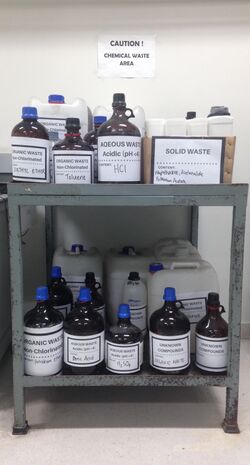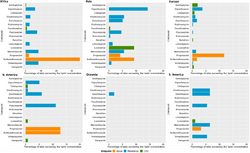Chemistry:Chemical waste
Chemical waste is any excess, unused, or unwanted chemical, especially those that cause damage to human health or the environment.[1] Chemical waste may be classified as hazardous waste,[2] non-hazardous waste, universal waste, or household hazardous waste.[3] Hazardous waste is material that displays one or more of the following four characteristics: ignitability, corrosivity, reactivity, and toxicity. This information, along with chemical disposal requirements, is typically available on a chemical's Material Safety Data Sheet (MSDS). Radioactive waste requires special ways of handling and disposal due to its radioactive properties. Biohazardous waste, which may contain hazardous materials, is also handled differently.
Laboratory chemical waste in the US

The U.S. Environmental Protection Agency (EPA) prohibits disposing of certain materials down drains.[4] Therefore, when hazardous chemical waste is generated in a laboratory setting, it is usually stored on-site in an appropriate waste carboy where it is later collected and disposed of by a specialist contractor in order to meet safety, health, and legislative requirements. Many universities' Environment, Health, and Safety (EHS) divisions/departments serve this collection and oversight role.[5][6][7][8]
Organic solvents and other organic waste is typically incinerated.[9][10][11][12] Some chemical wastes are recycled, such as waste elemental mercury.[13]
Laboratory waste containment

Packaging
During packaging, chemical liquid waste containers are filled to no further than 75% capacity to allow for vapor expansion and to reduce potential spills which can occur from transporting or moving overfilled containers. Containers for chemical liquid waste are typically constructed from materials compatible with the hazardous waste being stored, such as inert materials like polypropylene (PP) or polytetrafluoroethylene (PTFE). These containers are also constructed of mechanically robust materials in order to minimize leakage during storage or transit.
In addition to the general packaging requirements mentioned above, precipitates, solids, and other non-fluid wastes are typically stored separately from liquid waste. Chemically contaminated glassware is disposed of separately from other chemical waste in containers that cannot be punctured by broken glass.[14][15]
Labelling
Containers are labelled with the group name from the chemical waste category and an itemized list of the contents. All chemicals or materials contaminated by chemicals pose a significant hazard. All waste must be appropriately packaged.[16]
Storage
Chemical waste containers are kept closed to prevent spillage, except for when waste is being added. Suitable containers are labeled in order to inform disposal specialists of the contents, as well as to prevent addition of incompatible chemicals.[14] Liquid waste is stored in containers with secure screw-top or similar lids that cannot be easily dislodged in transit. Solid waste is stored in various sturdy, chemically inert containers, such as large sealed buckets or thick plastic bags. A secondary containment (e.g., flammable cabinet or large plastic bin, etc.) is used to capture spills and leaks from the primary container and segregate incompatible hazardous wastes, such as acids and bases.
Chemical compatibility guidelines
Many chemicals react adversely when combined. Incompatible chemicals are therefore stored in separate areas of laboratories.[17][18]
Acids are separated from alkalis, metals, cyanides, sulfides, azides, phosphides, and oxidizers, as when acids combine with these types of compounds, violent exothermic reactions can occur. In addition, some of these reactions produce flammable gases, which, combined with the heat produced, may cause explosions. In the case of cyanides, sulfides, azides, phosphides, etc. Toxic gases are also produced.
Oxidizers are separated from acids, organic materials, metals, reducing agents, and ammonia, as when oxidizers combine with these types of compounds, flammable and sometimes toxic compounds can be created. Oxidizers also increase the likelihood that any flammable material present will ignite, seen most readily in research laboratories with improper storage of organic solvents.[19]
Environmental pollution
Pharmaceuticals
PPCPs
River pollution

Textile industry

The textile industry is one of the largest polluters in the globalized world of mostly free market dominated socioeconomic systems.[citation needed] Chemically polluted textile wastewater degrades the quality of the soil and water.[20] The pollution comes from the type of conduct of chemical treatments used e.g., in pretreatment, dyeing, printing, and finishing operations[21] that many or most market-driven companies use despite "eco-friendly alternatives". Textile industry wastewater is considered to be one the largest polluters of water and soil ecosystems, causing "carcinogenic, mutagenic, genotoxic, cytotoxic and allergenic threats to living organisms".[22][23] The textile industry uses over 8000 chemicals in its supply chain,[24] also polluting the environment with large amounts of microplastics[25] and has been identified in one review as the industry sector producing the largest amount of pollution.[26]
A campaign of big clothing brands like Nike, Adidas and Puma to voluntarily reform their manufacturing supply chains to commit to achieving zero discharges of hazardous chemicals by 2020 (global goal)[27][28] appears to have failed.
The textile industry also creates a lot of pollution that leads to externalities which can cause large economic problems. The problem usually occurs when there is no division of ownership rights. This means that the problem of pollution is largely caused because of incomplete information about which company pollutes and at what scale the damage was caused by the pollution.
Planetary boundary
A study by "Scienmag" defines a 'planetary boundary' for novel entities such as plastic and chemical pollution. The study reported that the boundary has been crossed.[29][30][31][32]
Regulation of chemical waste
Chemicals waste may fall under regulations such as COSHH in the United Kingdom or the Clean Water Act and Resource Conservation and Recovery Act in the United States . In the U.S., the Environmental Protection Agency (EPA) and the Occupational Safety and Health Administration (OSHA), as well as state and local regulations, also regulate chemical use and disposal.[33]
Chemical waste in Canadian aquaculture
Chemical waste in oceans is becoming a major issue for marine life. There have been many studies conducted to try and prove the effects of chemicals in oceans.[34] In Canada, many of the studies concentrated on the Atlantic provinces, where fishing and aquaculture are an important part of the economy. In New Brunswick, a study was done on sea urchins in an attempt to identify the effects of toxic and chemical waste on life beneath the ocean, specifically the waste from salmon farms. Sea urchins were used to check the levels of metals in the environment. Green sea urchins have been used as they are widely distributed, abundant in many locations, and easily accessible. By investigating the concentrations of metals in the green sea urchins, the impacts of chemicals from salmon aquaculture activity could be assessed and detected. Samples were taken at 25-meter intervals along a transect in the direction of the main tidal flow. The study found that there were impacts to at least 75 meters based on the intestine metal concentrations.
See also
- Industrial waste
- List of waste types
- Municipal solid waste
- Radioactive waste
- Toxic waste
- Waste management
- Water pollution
References
- ↑ "Chemical Waste−an overview". Elsevier. https://www.sciencedirect.com/topics/earth-and-planetary-sciences/chemical-waste.
- ↑ US EPA, OLEM (2015-07-23). "Hazardous Waste" (in en). https://www.epa.gov/hw.
- ↑ US EPA, OLEM (2015-11-25). "Household Hazardous Waste (HHW)" (in en). https://www.epa.gov/hw/household-hazardous-waste-hhw.
- ↑ "Chemicals and Toxics Topics" (in en). 2016-11-17. https://www.epa.gov/environmental-topics/chemicals-and-toxics-topics.
- ↑ "Chemical Waste Management Guide | Environmental Health & Safety". https://www.bu.edu/ehs/ehs-topics/environmental/chemical-waste/chemical-waste-management-guide/.
- ↑ "Hazardous Waste Pick-Ups" (in en). 2016-11-23. https://ehs.ucla.edu/waste/services/hazardous-waste-schedule.
- ↑ "Exploring Whether Chemical Management Services are a Potential Mechanism to Facilitate the Reduction, Reuse and Recycling of Chemicals in Educational Institutions". EPA Archive document. August 29, 2022. https://archive.epa.gov/epawaste/hazard/wastemin/web/pdf/univ-report.pdf.
- ↑ Magriotis, Zuy; Saczk, Adelir; Salgado, Hélvia; Rosa, Isael (2021-07-30). "Chemical Waste Management in Educational Institutions". Journal of Environmental Science and Sustainable Development 4 (1): 160–176. doi:10.7454/jessd.v4i1.1064. ISSN 2655-6847. https://scholarhub.ui.ac.id/jessd/vol4/iss1/8.
- ↑ "New hazardous waste incinerator comes online". https://cen.acs.org/articles/95/i14/New-hazardous-waste-incinerator-comes.html.
- ↑ "Hazardous Waste Management Facilities and Units" (in en). 2015-07-29. https://www.epa.gov/hwpermitting/hazardous-waste-management-facilities-and-units.
- ↑ Shibamoto, T; Yasuhara, A; Katami, T (2007). "Dioxin formation from waste incineration". Reviews of Environmental Contamination and Toxicology 190: 1–41. doi:10.1007/978-0-387-36903-7_1. ISBN 978-0-387-36900-6. PMID 17432330.
- ↑ "Waste incineration". Luxembourg: European Union. http://europa.eu/legislation_summaries/environment/waste_management/l28072_en.htm.
- ↑ pubs.usgs.gov/circ/c1196u/Circ_1196_U.pdf
- ↑ 14.0 14.1 "Laboratory Waste Disposal". University of Wisconsin. 2007. https://www.chem.wisc.edu/deptfiles/docs/lab-waste-disposal-portrait.pdf.
- ↑ "General Requirements". University of Toronto. http://www.ehs.utoronto.ca/resources/wmindex/wm4.htm.
- ↑ "8. Management of Waste". Prudent Practices in the Laboratory: Handling and Management of Chemical Hazards: Updated Version. Washington, D.C.: National Research Council (US). 2011. ISBN 978-0-309-21158-1. https://www.ncbi.nlm.nih.gov/books/NBK55885/.
- ↑ "Chemical Storage Resources" (in en). https://www.acs.org/content/acs/en/about/governance/committees/chemical-safety/publications-resources/chemical-storage.html.
- ↑ "Chemical Compatibility and Segregation Guides". National Institutes of Health (US). http://orf.od.nih.gov/EnvironmentalProtection/WasteDisposal/Pages/chem_compat.aspx.
- ↑ "How to Store and Dispose of Hazardous Chemical Waste". University of California at San Diego. http://blink.ucsd.edu/safety/research-lab/hazardous-waste/chemical.html#Select-compatible-containers.
- ↑ Pattnaik, Punyasloka; Dangayach, G. S.; Bhardwaj, Awadhesh Kumar (1 June 2018). "A review on the sustainability of textile industries wastewater with and without treatment methodologies" (in en). Reviews on Environmental Health 33 (2): 163–203. doi:10.1515/reveh-2018-0013. ISSN 2191-0308. PMID 29858909.
- ↑ Madhav, Sughosh; Ahamad, Arif; Singh, Pardeep; Mishra, Pradeep Kumar (March 2018). "A review of textile industry: Wet processing, environmental impacts, and effluent treatment methods" (in en). Environmental Quality Management 27 (3): 31–41. doi:10.1002/tqem.21538.
- ↑ Kishor, Roop; Purchase, Diane; Saratale, Ganesh Dattatraya; Saratale, Rijuta Ganesh; Ferreira, Luiz Fernando Romanholo; Bilal, Muhammad; Chandra, Ram; Bharagava, Ram Naresh (1 April 2021). "Ecotoxicological and health concerns of persistent coloring pollutants of textile industry wastewater and treatment approaches for environmental safety" (in en). Journal of Environmental Chemical Engineering 9 (2): 105012. doi:10.1016/j.jece.2020.105012. ISSN 2213-3437. https://eprints.mdx.ac.uk/31782/1/JECE%202021%20author%27s%20copy%20-%20repository.pdf.
- ↑ Akhtar, Muhammad Furqan; Ashraf, Muhammad; Javeed, Aqeel; Anjum, Aftab Ahmad; Sharif, Ali; Saleem, Mohammad; Mustafa, Ghulam; Ashraf, Moneeb et al. (28 February 2018). "Association of textile industry effluent with mutagenicity and its toxic health implications upon acute and sub-chronic exposure" (in en). Environmental Monitoring and Assessment 190 (3): 179. doi:10.1007/s10661-018-6569-7. ISSN 1573-2959. PMID 29492685.
- ↑ Nimkar, Ullhas (1 February 2018). "Sustainable chemistry: A solution to the textile industry in a developing world" (in en). Current Opinion in Green and Sustainable Chemistry 9: 13–17. doi:10.1016/j.cogsc.2017.11.002. ISSN 2452-2236.
- ↑ Xu, Xia; Hou, Qingtong; Xue, Yingang; Jian, Yun; Wang, LiPing (20 November 2018). "Pollution characteristics and fate of microfibers in the wastewater from textile dyeing wastewater treatment plant". Water Science and Technology 78 (10): 2046–2054. doi:10.2166/wst.2018.476. ISSN 0273-1223. PMID 30629532.
- ↑ Behera, Meerambika; Nayak, Jayato; Banerjee, Shirsendu; Chakrabortty, Sankha; Tripathy, Suraj K. (1 August 2021). "A review on the treatment of textile industry waste effluents towards the development of efficient mitigation strategy: An integrated system design approach" (in en). Journal of Environmental Chemical Engineering 9 (4): 105277. doi:10.1016/j.jece.2021.105277. ISSN 2213-3437.
- ↑ "Destination Zero: seven years of Detoxing the clothing industry". Greenpeace. https://storage.googleapis.com/planet4-international-stateless/2018/07/destination_zero_report_july_2018.pdf.
- ↑ "Greenpeace Calls Out Nike, Adidas and Puma for Toxic Clothing" (in en). Reuters. 9 August 2011. https://www.reuters.com/article/idUS191991010320110809.
- ↑ "Chemical pollution has passed safe limit for humanity, say scientists" (in en). The Guardian. 18 January 2022. https://www.theguardian.com/environment/2022/jan/18/chemical-pollution-has-passed-safe-limit-for-humanity-say-scientists.
- ↑ "Safe planetary boundary for pollutants, including plastics, exceeded," (in en-US). 2022-01-18. https://scienmag.com/safe-planetary-boundary-for-pollutants-including-plastics-exceeded-researchers-say/.
- ↑ Persson, Linn; Carney Almroth, Bethanie M.; Collins, Christopher D.; Cornell, Sarah; de Wit, Cynthia A.; Diamond, Miriam L.; Fantke, Peter; Hassellöv, Martin et al. (1 February 2022). "Outside the Safe Operating Space of the Planetary Boundary for Novel Entities". Environmental Science & Technology 56 (3): 1510–1521. doi:10.1021/acs.est.1c04158. ISSN 0013-936X. PMID 35038861. Bibcode: 2022EnST...56.1510P.
- ↑ "Procedures for Laboratory Chemical Waste Disposal". St. John's, NL: Memorial University of Newfoundland. https://www.mun.ca/sgs/current/chem_waste.pdf.
- ↑ Hallam, Bill (April–May 2010). "Techniques for Efficient Hazardous Chemicals Handling and Disposal". Pollution Equipment News. p. 13. http://www.pollutionequipment-digital.com/pollutionequipment/20100405/?pg=17#pg13.
- ↑ Derraik, José G. B (2002-09-01). "The pollution of the marine environment by plastic debris: a review" (in en). Marine Pollution Bulletin 44 (9): 842–852. doi:10.1016/S0025-326X(02)00220-5. ISSN 0025-326X. https://www.sciencedirect.com/science/article/pii/S0025326X02002205.
Further reading
- Committee on Prudent Practices for Handling, Storage, and Disposal of Chemicals in Laboratories, National Research Council (16 September 1995). "7. Disposal of Waste" (online book). Prudent Practices in the Laboratory: Handling and Disposal of Chemicals. The National Academies Press. pp. 147–150. ISBN 978-0-309-05229-0. http://www.nap.edu/openbook.php?record_id=4911&page=139.
External links
- Industrial Materials Recycling – US EPA

